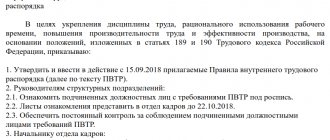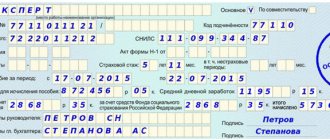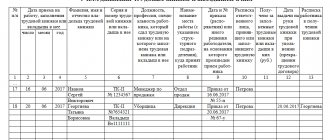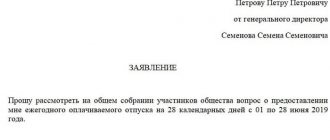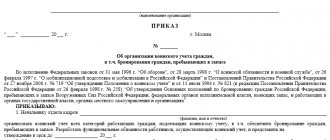Drawing up an act of refusal to write an explanatory note occurs in cases where an employee of an organization commits any offense, but does not want to give any explanations about it.
- Form and sample
- Free download
- Online viewing
- Expert tested
FILES
At the same time, the significance of the violation itself is determined by the superior boss - if, guided by the legislation of the Russian Federation and the internal regulations of the company, he considered it serious enough, then he has every reason to request an explanation from his subordinate.
Whether to give them or not, each employee decides independently - according to the law, drawing up an explanatory note is not an obligation, but an employee’s right, and no one has the right to force him to do this.
Explanatory letter
It is very difficult to overestimate the importance of an explanatory note, since it allows the head of the company:
- better understand the motives for which a particular violation was committed;
- more accurately determine the degree of guilt of the employee.
As a general rule, an explanatory note does not guarantee release from punishment. But in some situations, when a violation of discipline is associated with good reasons - illness of a relative, unforeseen circumstances, etc. (which can be documented) - disciplinary action cannot be applied.
Also see “Example of an explanatory note about a work error.”
Why register a refusal?
The document is drawn up when the employer asks the employee to give written explanations on any issue, but receives a refusal. It is impossible to force an employee to provide an explanatory note, but the fact of refusal must be recorded. This document can then be used to confirm that disciplinary action has been taken against the offender.
Reference. The severity of punishment from management directly depends on the severity of the violations committed by the employee.
Why do we need an act of refusal to write an explanatory note?
The presence of a document on refusal to give an explanation proves:
- guilt of the company employee;
- his lack of remorse for the violation committed.
Such an act allows the company management to legally take measures to punish the violator of labor discipline.
Disciplinary sanctions may be imposed in the form of:
- comments;
- reprimand;
- dismissals.
The type of penalty applied is prescribed in a separate management order. The more serious the violation, the more serious the punishment for it.
Also see: Reprimanding Foul Language at Work: Keeping Civility Safe.
The employee’s explanations regarding the violations he committed play an important role in the penalty procedure. However, employees of the enterprise have every right (for example, if they believe that this will directly or indirectly prove their guilt) not to give an explanation. And they actively use it.
As a rule, the employee’s explanations are made in writing in one or two copies. They must be signed by both parties.
Management is given 2 days to request an employee of the enterprise to provide an explanation regarding the violation. If an explanatory note is not submitted within the specified period, the organization is obliged to draw up an act on the employee’s refusal to give explanations.
It is important to understand that if an employee of an enterprise is found guilty and is given a penalty in the form of dismissal, he has the right to file a lawsuit to challenge this decision. Therefore, in this situation, a competently drawn up act and signed by 3 persons:
- will serve as direct evidence that written explanations were requested from the company employee, but he refused to provide them to his management;
- will mean that the imposition of a penalty in the form of subsequent dismissal of the employee was carried out in accordance with the current legislation of the Russian Federation.
Thus, the drafted sample act of refusal to write an explanatory note in itself in no way affects the application of a disciplinary sanction to the violator of labor discipline. However, without written explanations from the employee, management does not have the right to immediately punish him.
Also see “Failure to fulfill official duties and dismissal under the article.”
Normative base
Resolution of the plenum of the Supreme Court of the Russian Federation dated March 17, 2004 No. 2 “On the application by the courts of the Russian Federation of the Labor Code of the Russian Federation”
Drawing up an explanatory note according to the law is not the responsibility of the employee, but his right, therefore it is unlawful to force him to do this.
Cases when the employer is obliged to acknowledge the employee’s reluctance to give written explanations are regulated by Part 1 of Article 193 of the Labor Code of the Russian Federation. If disciplinary measures are applied to an employee, the employer is obliged to request an explanatory note from the employee before applying them. Two working days are given to submit an explanatory note, after which the absence of written explanations is recorded in the relevant document.
ConsultantPlus experts examined how to hold an employee accountable for failure to fulfill official duties. Use these instructions for free.
Requirements for the act
Any types of violations committed by employees at the enterprise must be reflected in a special document - an act. Thus, the act of refusal of an explanatory note is drawn up by the immediate supervisor of the violator with the participation of at least 2 persons - employees of this organization.
There is no generally accepted form of an act of refusal to give explanations. But it must contain the following information:
- Title of the document;
- on what basis was the act drawn up;
- information about the employee who refused to submit an explanatory note - full name, position held, department;
- information about the commission in whose presence the act of refusal to give explanations was drawn up (see sample below). The commission must consist of at least 3 people: all of them are company employees and the employer/immediate supervisor of the structural unit. It is also necessary to indicate the full name and position of the commission members. If the organization has a trade union body, then its representative must be a member of this commission;
- a detailed description of the violation of labor discipline that occurred;
- link to Part 1 of Art. 193 of the Labor Code of the Russian Federation, according to which the company’s management has the right to receive explanations from the employee;
- if an employee of the organization indicated the reason for his reluctance, then the sample act on the absence of an explanatory note prepared by the commission should reflect this fact;
- a note that the document is drawn up in 2 copies, one of which remains in the archives of the enterprise, and the second is given to the employee;
- date of document preparation;
- position and signature of the person who directly drew up the act.
Any ready-made sample act of refusal to write an explanatory note need not be sealed. Legislatively, since April 2015, legal entities have been exempt from the need to apply their official stamp on such documents.
The following shows a completed sample of an act of refusal to provide a written explanation:
| Limited Liability Company "Guru" (LLC "Guru") Act No. 1/17 on the employee's refusal to give a written explanation August 29, 2017 Moscow by a Commission consisting of the Chairman - head of the personnel department L.N. Pirogova, members - secretary Lushnikova Yu.D. and lawyer of the legal department Dmitriev N.V. This act has been drawn up stating that accountant Elena Alekseevna Shirokova was invited by notification No. 07 dated August 29, 2021 to provide her written explanations regarding the fact of absence from work in office No. 32 on August 29, 2021 from 9.30 to 14.00. From receipt of said notification No. 07 and giving written explanations to Shirokova E.A. refused without explanation. The notice was read out by E.A. Shirokova. aloud. Chairman of the commission, head of the personnel department____________Pirogov____________/Pirogova L.N./ Secretary____________Lushnikova____________/Lushnikova Y.D./ Lawyer of the legal department____________Dmitriev____________/Dmitriev N.V./ The act was reviewed on _____________ “__” August 2017____________/Shirokova E.A./ Shirokova E.A. refused to familiarize herself with this act. Chairman of the Commission, Head of the Human Resources Department____________Pirogov____________/Pirogova L.N./ Secretary____________Lushnikova____________/Lushnikova Yu.D./ Lawyer of the Legal Department____________Dmitriev____________/Dmitriev N.V./ In case No. 08-2017 Shlyapnikova |
Read also
29.09.2018
Who compiles and in what form
Most often, documenting the refusal to write an explanatory note is done by the person who requested it. Sometimes this is the immediate head of the department where the offender works, or another person who has requested an explanation. For the act to enter into legal force, witnesses, for example other employees, are involved in its preparation.
Thus, to draw up an act, assemble a small commission of at least three people. For example, the manager, secretary and personnel officer or lawyer of the organization. There is no specific list of employees included in the commission in the law.
The document is drawn up in a free style. The number of copies is not strictly regulated.
Explanatory note for absenteeism at work: sample statement and how to write
Dear readers! Our articles talk about typical ways to resolve legal issues, but each case is unique. If you want to find out how to solve your particular problem, please use the online consultant form on the right or call ext.
738. It's fast and free!
For some reason the person did not show up for work.
What is an explanatory note for absenteeism at work, a sample design, and what significance is attached to this document? The reasons for absenteeism can be different - from force majeure events to banal binge drinking.
But if 20 years ago it was possible to come up with a plausible story and present it to management, now most stories will be broken down by the simple question of why you didn’t call or at least send an SMS.
The unexpected failure of a cell phone will only cause additional suspicions in the boss.
How to write an explanatory note about absenteeism to avoid negative consequences?
The place and meaning of the explanatory note when registering truancy
Absenteeism will be the absence of an employee from his place for the entire working day or 4 hours in a row. The document flow and procedure for registering absenteeism are determined by the Labor Code of the Russian Federation and include:
- Recording of misconduct. In connection with the absence of an employee, a report is drawn up indicating the date and time of absence. The act is signed by the truant’s supervisor and at least two colleagues. When the employee appears, he is introduced to the act for signature or a note is made about his refusal to sign.
- Failure to appear due to unknown circumstances is indicated on the report card.
- Management will request written explanations from the employee regarding the violation of discipline. 2 working days are given for preparation.
- If an explanatory note is not provided, a corresponding act is drawn up.
- Regardless of whether an explanatory note is presented or not, management decides whether to hold the person accountable or recognize the reasons for non-appearance as valid.
- When held accountable, a corresponding order is issued and announced to the employee. When dismissal for absenteeism, the necessary documents are drawn up and an entry is made in the work book.
- Corrections are made to the report card. In case of absence for a reason recognized as valid, the corresponding mark is given on the report card (for example, B - sick, OZ - leave without salary). When confirming absenteeism, the PR is indicated.
An explanatory note is the only and fundamental document that can save the situation and save the employee from a reprimand or even dismissal.
A single absence is sufficient grounds for termination of the employment relationship. There is no reason to expect that the administration will incorrectly document the violation.
Management treats documents drawn up upon dismissal due to the fault of an employee with increased attention.
Registration of an explanatory note
The explanatory note is drawn up in any form in compliance with generally established rules of office work. In the upper right corner the position and full name of the manager, the position and full name of the absentee are indicated.
Below in the center is the name of the document: explanatory note or simply explanatory note. The following are explanations for absence from work.
The explanatory note must indicate the dates of absence, and explanations are given for each day of absence.
At the end of the document, a signature and the current date are affixed, supporting documents and evidence are attached.
You can compose an explanatory note on a computer or write it yourself.
The finished document is transferred to the responsible employee of the HR department or manager in accordance with the procedure established in the company.
Explanatory notes are not made in 2 copies to mark delivery.
It is advisable to prepare a copy with a stamp on the time of reception and an indication of the employee who received it if you intend to sue about being held accountable for absenteeism.
Sample explanatory note
For clarity, we provide an example.
| to CEO OOO "…" Full name sales manager Full name |
| Explanatory "__"______20_g. was absent from work throughout the day due to being in police custody, OP No. 4. On the way to work, two unknown men attacked, beat him up and stole his phone and wallet. From 9-15 to 16-30 he underwent a medical examination, gave testimony and participated in operational activities (compiled an identikit, looked through photographs). Applications (copies): 1. KUSP coupon. 2. Resolution to initiate a criminal case. Full name Date of. |
What and how to write
Considering that there is liability for absenteeism up to and including dismissal, the preparation of an explanatory note must be taken very seriously.
Your future work in the company may depend on what you write. An entry in the work book about dismissal for absenteeism will almost completely exclude or complicate the possibility of employment in a new place.
What and how to write depends on the actual circumstances and the relationship with the manager. It is often better to honestly admit the disrespect of absenteeism, have a confidential conversation with the manager and get off with a reprimand or loss of bonus, than to come up with implausible stories in the hope of avoiding punishment.
Force majeure and valid reasons
You must notify your manager if you are late or unable to show up for work.
If you called your boss and reported your absence or tardiness and explained the objective and valid reasons, the issue of absenteeism in most cases will not be raised. After returning to work, it is enough to register days of rest without pay or as vacation.
Absenteeism will occur if the reasons for non-appearance are unknown. With respect, it is necessary to explain why management was not warned by telephone about the impossibility of coming to work.
Force majeure can be a major accident and a broken phone as a result of the accident, etc.
The most fantastic circumstances may arise in life that force you to take truancy. In such cases, it is necessary to provide an evidence base.
For example, provide medical documents, demonstrate a damaged phone, etc.
The procedure for giving explanations for an offense
Any violation committed by an employee must be recorded in a special act. This document is drawn up by his immediate superior with the involvement of at least two witnesses (also employees of the organization).
The act must record:
- time,
- place of the offense committed
- the essence of the offense.
Next, the manager is obliged to demand an explanation from the subordinate. In this case, the employee has the right to give them both orally and in writing .
Written documents are necessary only if they allow you to analyze and evaluate the weight and validity of the reasons for the offense and can directly affect the severity of the possible punishment.
By law, the period for requesting and issuing an explanatory note may be determined by the company’s internal regulations, but in any case, it should not exceed one month.
If an employee writes an explanatory note, then in the future it either serves as a justification for releasing him from punishment, or becomes the basis for an order to impose a disciplinary sanction.
If the employee refuses to give written explanations, then after three days the employer has the right to draw up a corresponding act.
The main sections of the document are as follows:
- The name and number of the document, the name of the organization, as well as the place, time and date of drawing up the act.
- Recording the fact that the employee guilty of the misconduct refused to give a written explanation for the misconduct. (For example: The commission, consisting of......drew up a report stating that...(full name)...refused to provide a written explanation of the situation...)
- A list of circumstances leading to a disciplinary offense is prescribed. Be sure to indicate the fact that the employee was given time to provide an explanatory statement.
- Signatures of the commission and employee. If the employee refuses, then this must also be written down in the act.
The act is drawn up in one copy and attached to the case regarding the consideration of the disciplinary offense. Shelf life: 5 years.
Types of disciplinary punishments
The employer may bring the employee to disciplinary liability for violation of internal labor regulations, safety requirements, labor protection instructions, provisions of the job description and employment contract, etc. In accordance with Art. 192 of the Labor Code of the Russian Federation the following may be applied to an employee:
- comment;
- rebuke;
- dismissal.
Separate laws may stipulate other types of disciplinary sanctions.
Regardless of the type of punishment, the employer can bring the employee to disciplinary liability only after requesting an explanation from him.
Sample and form of the document in 2021
In 2021, the legislator does not establish a standard unified form/form of the document in question as a prerequisite for its execution. But it does not prohibit the use of this sample, which already contains all the necessary columns and fields.
At the same time, most managers of large companies use specially designed letterheads for these purposes , which correspond to the needs and characteristics of the organization itself.
Medium and small companies, as a rule, draw up an act in free form, using a blank sheet of A4 paper and a ballpoint pen with dark ink.
Form
As a rule, developing a template for drawing up such a document is the responsibility of the employer himself.
Although the law allows you to draw up an act in a free style. All the important details are displayed here:
- Actions that need explanation;
- the very fact of refusal to give any explanation is indicated.
Naturally, the act must contain information about the company and its director. Information about the employee in respect of whom the report is being drawn up is also indicated. The members of the commission are also listed here. You can often encounter a situation where an employee does not want to sign the drafted document. This also needs to be shown in the document. In addition, you can additionally draw up a new act related to the employee’s refusal to sign the original act.
The role of explanatory
As you might guess, with any unusual behavior of his subordinate, the manager wants to receive intelligible explanations.
Often, an employee does not wait for the director’s request, but independently wants to explain why he did what he did. After reviewing the explanations provided by the employee, the manager determines how guilty the employee is and chooses a punishment for him. But you can often encounter a situation where there are good reasons for certain actions. For example, these could be unexpected illnesses or circumstances that the employee could not influence. As a rule, the employee attaches documents confirming the reason to the explanatory note. In such situations, the director cannot take disciplinary action.
( Video : “How to write correctly and submit an explanatory note to your boss.”)
How to draw up a deed
The legislation does not impose any special requirements on both the information part of the act and its execution: the document can be printed on a computer or written by hand, on a simple blank sheet or on company letterhead.
It is important to comply with only one condition: the act must be signed by the direct compiler, as well as by the members of the commission who were present at its creation. It is advisable to obtain the autograph of the offending employee, and if he refuses, an appropriate note should be made in the document.
It is not necessary to certify a document with a seal, since from 2021 legal entities are exempted by law from the requirement to use stamps in their activities.
It is enough to draw up the act in a single copy, but if necessary, you can make the required number of copies.

